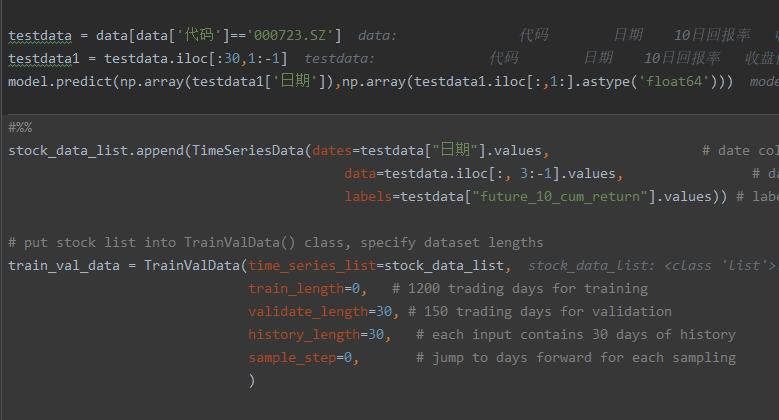Below is the structure of AlphaNetV2
input: (batch_size, history time steps, features)
stride = 5
input -> expand features -> BN -> LSTM -> BN -> Dense(linear)
Below is the structure of AlphaNetV3
input: (batch_size, history time steps, features)
stride = 5
+-> expand features -> BN -> GRU -> BN -+
input --| stride = 10 |- concat -> Dense(linear)
+-> expand features -> BN -> GRU -> BN -+
Either clone this repository or just use pypi: pip install alphanet.
The pypi project is here: alphanet.
from alphanet import AlphaNetV3, load_model
from alphanet.data import TrainValData, TimeSeriesData
from alphanet.metrics import UpDownAccuracy# read data
df = pd.read_csv("some_data.csv")
# compute label (future return)
df_future_return = here_you_compute_it_by_your_self
df = df_future_return.merge(df,
how="inner",
left_on=["date", "security_code"],
right_on=["date", "security_code"])
# create an empty list
stock_data_list = []
# put each stock into the list using TimeSeriesData() class
security_codes = df["security_code"].unique()
for code in security_codes:
table_part = df.loc[df["security_code"] == code, :]
stock_data_list.append(TimeSeriesData(dates=table_part["date"].values, # date column
data=table_part.iloc[:, 3:].values, # data columns
labels=table_part["future_10_cum_return"].values)) # label column
# put stock list into TrainValData() class, specify dataset lengths
train_val_data = TrainValData(time_series_list=stock_data_list,
train_length=1200, # 1200 trading days for training
validate_length=150, # 150 trading days for validation
history_length=30, # each input contains 30 days of history
sample_step=2, # jump to days forward for each sampling
train_val_gap=10 # leave a 10-day gap between training and validation# get one training period that start from 20110131
train, val, dates_info = train_val_data.get(20110131, order="by_date")
print(dates_info)# get an AlphaNetV3 instance
model = AlphaNetV3(l2=0.001, dropout=0.0)
# you may use UpDownAccuracy() here to evaluate performance
model.compile(metrics=[tf.keras.metrics.RootMeanSquaredError(),
UpDownAccuracy()]
# train
model.fit(train.batch(500).cache(),
validation_data=val.batch(500).cache(),
epochs=100)# save model by save method
model.save("path_to_your_model")
# or just save weights
model.save_weights("path_to_your_weights")# load entire model using load_model() from alphanet module
model = load_model("path_to_your_model")
# only load weights by first creating a model instance
model = AlphaNetV3(l2=0.001, dropout=0.0)
model.load_weights("path_to_your_weights")Note: only alphanet.load_model(filename) recognizes custom UpDownAccuracy.
If you do not use UpDownAccuracy,
you can also use tf.keras.models.load_model(filename).
For detailed documentation, go to alphanet documentation.
For implementation details, go to alphanet source folder.
The model expands features quadratically. So, if you have 5 features, it will be expanded to more than 50 features (for AlphaNetV3), and if you have 10 features, it will be expanded to more than 200 features. Therefore, do not put too many features inside.
alphanet.datamodule is completely independent from alphanet module,
and can be a useful tool for training any timeseries neural network.

